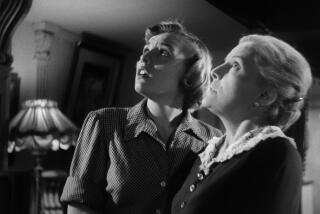Monty: An actor of fragile brilliance
“Look, I’m not odd. I’m just trying to be an actor; not a movie star, an actor”-- Montgomery Clift
Several of the recent Marlon Brando obituaries mentioned Montgomery Clift as one of the actor’s contemporaries. But Clift was more than a contemporary. He, along with John Garfield, opened the door for the likes of such Method actors as Brando, James Dean, Paul Newman and Steve McQueen. Clift made his Broadway debut nearly a decade before Brando and was a full-fledged movie star by the time Brando appeared in his first film, 1950’s “The Men.”
Beginning Sept. 10, the Los Angeles County Museum of Art’s film department is offering a three-week retrospective of the actor’s haunting work, “Monty: The Films of Montgomery Clift.”
Sensitive, broody and introspective, Clift was probably one of the most striking men ever to appear on screen. Clift could express every emotion with his startling blue eyes. But his film career lasted less than 20 years. Clift made only 17 films -- receiving four Oscar nominations -- before his personal demons finally overtook him.
Like Brando, Clift hailed from Omaha. He made his Broadway debut at 14 in the comedy “Fly Away Home,” and over the next decade, he appeared in such respected plays as Robert Sherwood’s “There Shall Be No Night,” Thornton Wilder’s “The Skin of Our Teeth” and Lillian Hellman’s “The Searching Wind.”
Hollywood came knocking in the early ‘40s when MGM wanted him for the role of Greer Garson’s son in “Mrs. Miniver.” But Clift turned down the offer. He was finally lured to Hollywood in 1947 when he was cast as John Wayne’s rebellious adopted son in “Red River.” The classic Howard Hawks western opens the LACMA festival.
Clift was a new kind of leading man -- sensitive, shy and not afraid to show his emotions on screen. And he wasn’t worried about playing a villain, like the charming but conniving fortune hunter in William Wyler’s 1949 film “The Heiress,” which screens Sept. 18.
He quickly achieved heartthrob status, though Hollywood kept it under wraps that its latest sex symbol was gay.
Like the majority of his characters, Clift was an outsider in Hollywood. He didn’t sign a seven-year contract with any studio and was picky about his projects. He turned down such classic films as “Sunset Boulevard” and “Shane.”
The LACMA festival highlights several of Clift’s best-known films. The Sept. 11 double bill, in fact, features two of his Oscar-nominated performances. In 1951’s “A Place in the Sun,” he gives an indelible turn in George Stevens’ drama as an ambitious but ill-fated young man. His love scene with Elizabeth Taylor is one of the most erotic moments on film.
He perhaps gives his most nuanced performance in the multi-Oscar-winning 1953 war drama “From Here to Eternity,” as an honorable Army private who sticks to his code no matter what.
Peaks and valleys
Also included in the festival are such rarities as “Terminal Station” (Sept. 10), a 1953 melodramatic love story he made in Italy with Jennifer Jones for director Vittorio de Sica. Jones’ husband, the producer David O. Selznick, cut 17 minutes out of the movie for American audiences and retitled it “Indiscretion of an American Wife.” Though Clift is miscast as Jones’ illicit lover, he brings great passion and conviction to the project.
Despite his professional success, Clift suffered from chronic colitis -- it had kept him out of the service during World War II -- and had a severe drinking and pill problem. He spent a great deal of time and money in therapy.
After a three-year absence from the screen, he went to work in 1956 on the lavish MGM Civil War drama “Raintree County” (Sept. 24), which reunited him with good friend Taylor. One night after leaving friend Kevin McCarthy’s house, Clift was in a serious auto accident, which destroyed his face. With his jaw wired and in severe pain, he finished the film.
Though the accident exacerbated his dependence on alcohol and pills, Clift gave some of his best performances after the crash. He’s utterly heartbreaking as a battle-scarred rodeo performer in 1961’s “The Misfits” (Sept. 25). And he received his fourth and final Oscar nomination as a victim of the Nazis in 1961’s “Judgment at Nuremberg.”
Frail and looking far older than his 45 years, Clift returned to the screen one last time in the embarrassingly inept 1966 spy thriller “The Defector.” He was set to join Taylor in “Reflections in a Golden Eye” when his companion, Lorenzo James, found him dead of a heart attack on top of his bed in his New York brownstone.
Wrote Hollywood columnist Sheilah Graham: “He was only forty-five when he died. It would have been better for this sensitive man that he had never come to Hollywood, never heard the shrill trumpet of success and the canned laughter of this desperate insecure society.”
More to Read
Only good movies
Get the Indie Focus newsletter, Mark Olsen's weekly guide to the world of cinema.
You may occasionally receive promotional content from the Los Angeles Times.











